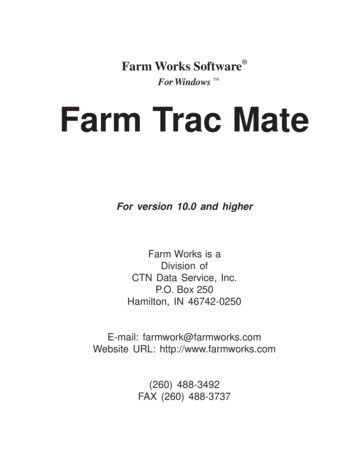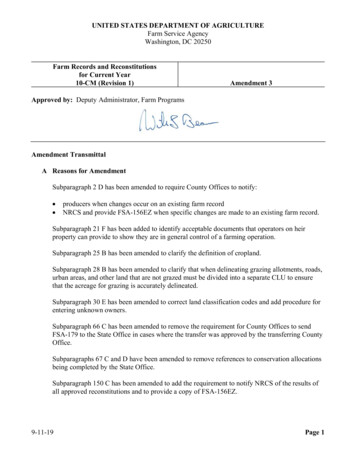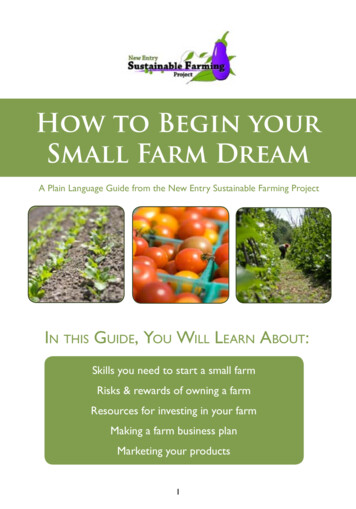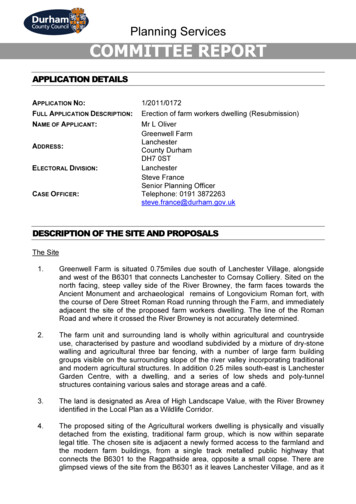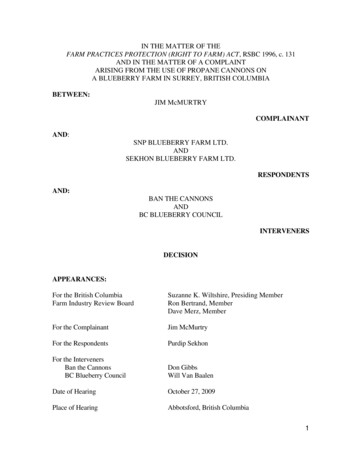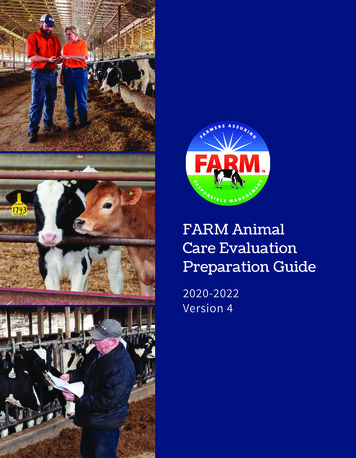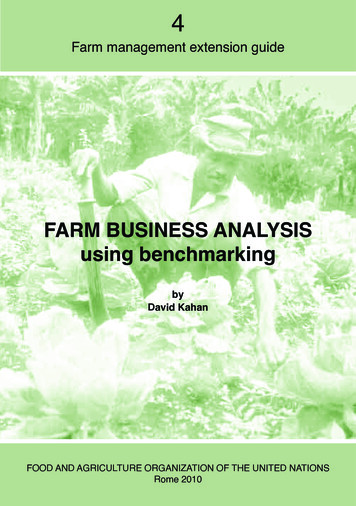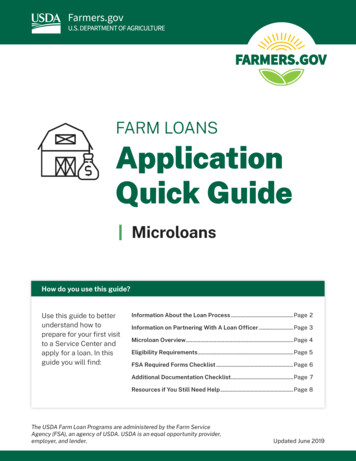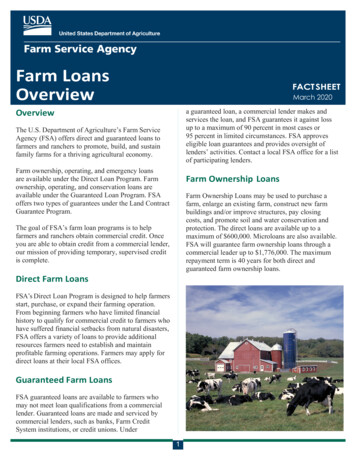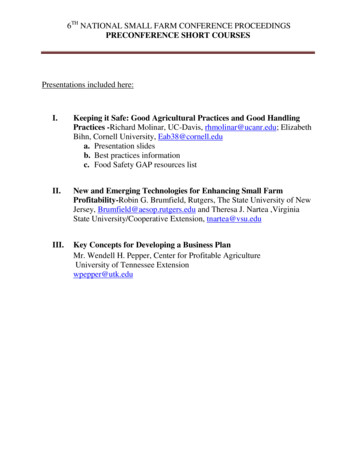
Transcription
6TH NATIONAL SMALL FARM CONFERENCE PROCEEDINGSPRECONFERENCE SHORT COURSESPresentations included here:I.Keeping it Safe: Good Agricultural Practices and Good HandlingPractices -Richard Molinar, UC-Davis, rhmolinar@ucanr.edu; ElizabethBihn, Cornell University, Eab38@cornell.edua. Presentation slidesb. Best practices informationc. Food Safety GAP resources listII.New and Emerging Technologies for Enhancing Small FarmProfitability-Robin G. Brumfield, Rutgers, The State University of NewJersey, Brumfield@aesop.rutgers.edu and Theresa J. Nartea ,VirginiaState University/Cooperative Extension, tnartea@vsu.eduIII.Key Concepts for Developing a Business PlanMr. Wendell H. Pepper, Center for Profitable AgricultureUniversity of Tennessee Extensionwpepper@utk.edu
6TH NATIONAL SMALL FARM CONFERENCE PROCEEDINGSPRECONFERENCE SHORT COURSESKeeping it Safe: Good Agricultural Practices and Good Handling PracticesRichard Molinar, UC-Davis,rhmolinar@ucanr.eduElizabeth Bihn, Cornell UniversityEab38@cornell.edu
6TH NATIONAL SMALL FARM CONFERENCE PROCEEDINGSPRECONFERENCE SHORT COURSES
6TH NATIONAL SMALL FARM CONFERENCE PROCEEDINGSPRECONFERENCE SHORT COURSES
6TH NATIONAL SMALL FARM CONFERENCE PROCEEDINGSPRECONFERENCE SHORT COURSES
6TH NATIONAL SMALL FARM CONFERENCE PROCEEDINGSPRECONFERENCE SHORT COURSES
6TH NATIONAL SMALL FARM CONFERENCE PROCEEDINGSPRECONFERENCE SHORT COURSES
6TH NATIONAL SMALL FARM CONFERENCE PROCEEDINGSPRECONFERENCE SHORT COURSES
6TH NATIONAL SMALL FARM CONFERENCE PROCEEDINGSPRECONFERENCE SHORT COURSES
6TH NATIONAL SMALL FARM CONFERENCE PROCEEDINGSPRECONFERENCE SHORT COURSES
6TH NATIONAL SMALL FARM CONFERENCE PROCEEDINGSPRECONFERENCE SHORT COURSES
6TH NATIONAL SMALL FARM CONFERENCE PROCEEDINGSPRECONFERENCE SHORT COURSES
6TH NATIONAL SMALL FARM CONFERENCE PROCEEDINGSPRECONFERENCE SHORT COURSES
6TH NATIONAL SMALL FARM CONFERENCE PROCEEDINGSPRECONFERENCE SHORT COURSES
6TH NATIONAL SMALL FARM CONFERENCE PROCEEDINGSPRECONFERENCE SHORT COURSES
6TH NATIONAL SMALL FARM CONFERENCE PROCEEDINGSPRECONFERENCE SHORT COURSES
6TH NATIONAL SMALL FARM CONFERENCE PROCEEDINGSPRECONFERENCE SHORT COURSES
6TH NATIONAL SMALL FARM CONFERENCE PROCEEDINGSPRECONFERENCE SHORT COURSES
6TH NATIONAL SMALL FARM CONFERENCE PROCEEDINGSPRECONFERENCE SHORT COURSES
6TH NATIONAL SMALL FARM CONFERENCE PROCEEDINGSPRECONFERENCE SHORT COURSES
6TH NATIONAL SMALL FARM CONFERENCE PROCEEDINGSPRECONFERENCE SHORT COURSES
6TH NATIONAL SMALL FARM CONFERENCE PROCEEDINGSPRECONFERENCE SHORT COURSES
6TH NATIONAL SMALL FARM CONFERENCE PROCEEDINGSPRECONFERENCE SHORT COURSES
6TH NATIONAL SMALL FARM CONFERENCE PROCEEDINGSPRECONFERENCE SHORT COURSES
6TH NATIONAL SMALL FARM CONFERENCE PROCEEDINGSPRECONFERENCE SHORT COURSES
6TH NATIONAL SMALL FARM CONFERENCE PROCEEDINGSPRECONFERENCE SHORT COURSES
6TH NATIONAL SMALL FARM CONFERENCE PROCEEDINGSPRECONFERENCE SHORT COURSES
6TH NATIONAL SMALL FARM CONFERENCE PROCEEDINGSPRECONFERENCE SHORT COURSES
6TH NATIONAL SMALL FARM CONFERENCE PROCEEDINGSPRECONFERENCE SHORT COURSES
6TH NATIONAL SMALL FARM CONFERENCE PROCEEDINGSPRECONFERENCE SHORT COURSES
6TH NATIONAL SMALL FARM CONFERENCE PROCEEDINGSPRECONFERENCE SHORT COURSES
6TH NATIONAL SMALL FARM CONFERENCE PROCEEDINGSPRECONFERENCE SHORT COURSES
6TH NATIONAL SMALL FARM CONFERENCE PROCEEDINGSPRECONFERENCE SHORT COURSES
6TH NATIONAL SMALL FARM CONFERENCE PROCEEDINGSPRECONFERENCE SHORT COURSES
6TH NATIONAL SMALL FARM CONFERENCE PROCEEDINGSPRECONFERENCE SHORT COURSES
6TH NATIONAL SMALL FARM CONFERENCE PROCEEDINGSPRECONFERENCE SHORT COURSES
6TH NATIONAL SMALL FARM CONFERENCE PROCEEDINGSPRECONFERENCE SHORT COURSES
6TH NATIONAL SMALL FARM CONFERENCE PROCEEDINGSPRECONFERENCE SHORT COURSES
6TH NATIONAL SMALL FARM CONFERENCE PROCEEDINGSPRECONFERENCE SHORT COURSES
6TH NATIONAL SMALL FARM CONFERENCE PROCEEDINGSPRECONFERENCE SHORT COURSES
6TH NATIONAL SMALL FARM CONFERENCE PROCEEDINGSPRECONFERENCE SHORT COURSES
6TH NATIONAL SMALL FARM CONFERENCE PROCEEDINGSPRECONFERENCE SHORT COURSES
6TH NATIONAL SMALL FARM CONFERENCE PROCEEDINGSPRECONFERENCE SHORT COURSES
6TH NATIONAL SMALL FARM CONFERENCE PROCEEDINGSPRECONFERENCE SHORT COURSES
6TH NATIONAL SMALL FARM CONFERENCE PROCEEDINGSPRECONFERENCE SHORT COURSES
6TH NATIONAL SMALL FARM CONFERENCE PROCEEDINGSPRECONFERENCE SHORT COURSES
6TH NATIONAL SMALL FARM CONFERENCE PROCEEDINGSPRECONFERENCE SHORT COURSESNew and Emerging Technologies for Enhancing Small Farm ProfitabilityRobin G. BrumfieldRutgers, The State University of New Jersey55 Dudley Road, New Brunswick, NJ 08901-8520Brumfield@aesop.rutgers.eduFarm decision-making must be based on accurate and timely information (Brumfield,2010). Adopting and integrating technology into marketing practices enhances competitiveadvantage by amplifying marketing messages through record keeping and cost accountingprograms. A simple Rutgers Cost Accounting Program, developed in Microsoft Excel anddistributed by Rutgers University lets farmers determine the costs and returns of each crop thatthey produce. The program calculates costs of crops produced outdoors as well as greenhousecrops. It generates information showing total costs, and net returns per unit. It enables producersto easily determine the profitability of each crop. From this information, they can determinewhich crops are their winners and losers. This software also will help farmers make decisions onpricing, identifying and reducing unprofitable production costs and increasing sales of profitablecrops.The Rutgers Cost Accounting Program calculates the percentages of each overhead costby using information that growers take from their income statement and input into the program.The program combines this with information from the balance sheet, to calculate 17 keyfinancial ratios. In addition to analyzing their actual costs, farmers can use the program as aplanning tool to analyze the impact of increased costs, changes in prices, changes in marketingmixes, or other changes they are considering.Tables 1 and 2 show figures from an example Northeast farm with sales of 2.2 million,and net returns of 211,455 or 9.5%. The farm has a 138,759 square feet greenhouse and growspetunia flats, marigold flats, geranium flats, geraniums in 4-inch pots, poinsettias in 6-inch potsand an acre of outdoor cut flowers. Table 1 shows basic production inputs needed to calculatecost per square foot per week. Table 2 summarizes information from the income statement andcalculates each cost as a percentage of sales. If we take those same numbers and triple energycosts (which has happened over the last decade), the net losses are 37,585 or -1.7% of sales.Taking this further, we can use the program to show that if we inflate prices of crops by 5% afterincreasing fuel costs, the net returns become positive (Tables 2 and 3). All crops, bothgreenhouse and outdoors, are profitable in in the base example, but, when we increase energycosts, then geranium flats and poinsettias become unprofitable. If we then increase sales pricesby 5%, the net returns for the greenhouse become positive ( 73,393), but poinsettias andgeranium flats are still slightly unprofitable.One method of assessment is financial analysis using financial ratios. Using numbersfromthe balance sheet and income statement, the program calculates the ratios which fall into fourcategories: profitability, financial efficiency, liquidity, and solvency. Table 4 shows the resultsfrom the base example. The program calculates each ratio, gives a recommendation for what theratio should be, shows the formula for calculating the ratio, and provides an explanation as towhat the ratio means for the farm.
6TH NATIONAL SMALL FARM CONFERENCE PROCEEDINGSPRECONFERENCE SHORT COURSESWith rising energy costs and competitive markets, managers need to pay close attentionto the bottom line and how changes in costs impact it. The Rutgers Cost Accounting Programallows farmers to do “what if” planning on paper instead of making bigger, real mistakes on thefarm. For more information, contact Dr. Robin G. Brumfield, 55 Dudley Road, RutgersUniversity, New Brunswick, NJ 08901-8520, phone 848/932-9130, e-mail:Brumfield@aesop.rutgers.edu.Literature CitedBrumfield, R.G. 2010. Strategies Producers in the Northeastern United States Are Using toReduce Costs and Increase Profits in Tough Economic Times. HortTechnology 20(5):836843.Table 1. An example of production inputs, which includes names of specific crops,number of units started, area used to produce each unit, production time, percentage sold,and sales price.CropsNumber ofunits startedSquare feetper unitWeeks togrowPercent soldSales tdoor 1.641.640.1111 acre8613615150.98 7.930.98 7.000.98 11.730.95 1.660.95 5.460.95 4.00
6TH NATIONAL SMALL FARM CONFERENCE PROCEEDINGSPRECONFERENCE SHORT COURSESTable 2. Baseline income statement data, the same data except for tripled energy costs, andthe same data with tripled energy costs and sales prices being increased by 5%.BaseTripled Fuel CostsTripled Fuel Costs/Sales Prices Increased5%% of Sales 2,330,538100.0% 2,219,560% ofSales100.0% 2,219,560% ofSales100.0%Seeds, cuttings, or plants 490,54022.1% 490,54022.1% 490,54021.0%Pots or containers 141,1806.4% 141,1806.4% 141,1806.1% 6,9150.3% 6,9150.3% 6,9150.3%Growing medium 37,3411.7% 37,3411.7% 37,3411.6%Fertilizer and chemicals 40,7531.8% 40,7531.8% 40,7531.7%Tags 60,1602.7% 60,1602.7%2.6% 2,8750.1% 2,8750.1% 60,160 2,875 9980.0% 9980.0% 9980.0% 42,5621.9% 42,5621.9% 728,49632.8% 728,49632.8%Heating fuel/Machinery Fuel 77,5663.5% 232,69810.5% 232,69810.0%Electricity 40,3521.8% 40,3521.8% 40,3521.7%Telephone 5,8940.3% 5,8940.3% 5,8940.3% 4640.0% 4640.0% 4640.0% 92,6424.2% 92,6424.2% 92,6424.0%Interest 8,0800.4% 8,0800.4%0.3%Repairs 43,8292.0% 43,8292.0% 8,080 43,829Taxes 26,1311.2% 26,1311.2% 26,1311.1%Insurance 37,5461.7% 37,5461.7% 37,5461.6%Advertising 11,2770.5% 11,2770.5% 11,2770.5%Travel and entertainment 7,4310.3% 7,4310.3% 7,4310.3%Office expense 9,5890.4% 9,5890.4% 9,5890.4% 19,4440.9% 19,4440.9% 19,4440.8% 46,9542.1% 140,8626.3% 2,1120.1% 2,1120.1%Miscellaneous 26,9741.2% 26,974Total expenses 2,008,10590.5% 2,257,145 Sales Directs costsMarketing containersSales CommissionsOtherOverhead salaries (includingbenefits)General wages (includingbenefits)UtilitiesWater 42,562 al feesTruck expense andequipment rentalLand rental 140,8621.9%6.0%0.1%1.2% 2,112 26,974101.7% 2,257,14696.9%1.2%
6TH NATIONAL SMALL FARM CONFERENCE PROCEEDINGSPRECONFERENCE SHORT COURSESNet ReturnsGreenhouse area (ft²) 211,4559.5%138,759Greenhouse space used for production (%)Weeks in operation (52 if a40full year)( 37,585)-1.7%138,75975 73,393138,75975403.1%7540
6TH NATIONAL SMALL FARM CONFERENCE PROCEEDINGSPRECONFERENCE SHORT COURSESTable 3. An example from the Greenhouse Cost Accounting program of outputinformation per units and per crop using 2003 Northeast cost.CropsSalesProfit(loss) percropProfit(loss) perunitProfit(loss) per sq.ft-wkSales pricePetuniaMarigoldGeraniumflatsflatsflats 388,570 343,000 63,004Geraniums PoinsettiasOutdoorCutFlowers 574,770(4-inchpots) 157,700(6-inchpots) 653,562 44,950 42,911 18,350 69,918 19,201 1.29 0.92 0.88 0.19 0.58 0.77 0.10 0.09 0.04 0.28 0.03 0.03 7.93 7.00 11.73 1.66 5.46Everything held constant, but energy costs tripled. 388,570 343,000 574,770 157,700 653,562 4.00(bunches) 99,317Sales 99,317Profit(loss) per 16,464 10,045( 32,717) 13,668( 64,169) 19,141cropProfit(loss) per 0.34 0.21( 0.67) 0.14( 0.54) 0.77unitProfit(loss) per sq. 0.03 0.02( 0.03) 0.21( 0.03) 0.03ft-wkSales price 7.93 7.00 11.73 1.66 5.46 4.00Everything held constant, but energy costs tripled and sales prices increased 5%.Sales 407,999 360,150 603,508 165,585 686,240 104,283Profit (loss) 35,892 27,195( 3,979) 21,553( 31,491) 24,107per cropProfit (loss) 0.73 0.56( 0.08) 0.23( 0.26) 0.97per unitProfit (loss) 0.05 0.06( 0.00) 0.33( 0.02) 0.04per sq. ft-wkSales Price 8.33 7.35 12.32 1.26 5.25 4.20
6TH NATIONAL SMALL FARM CONFERENCE PROCEEDINGSPRECONFERENCE SHORT COURSESTable 4. Financial ratios calculated for the example farm presented in the other tables.ProfitabilityMeasureNet Income(Profit)Gross MarginProfit MarginReturn onEquityReturn onAssetsThe ability to earn a good profit and generate satisfactory return on investment.YourRecommendation FormulaExplanationFigureWhat remains after subtracting allthe costs (including depreciation,Sales - Total 50,000 perinterest, salaries, and taxes) from 211,455Costsfamilyyour sales. Also called bottomline, net earnings, net profit.(Sales - TotalThe amount of contribution to theDirect Costs) /business enterprise, after paying64.82%30-40%Salesdirect costs.Profit per dollar of sales afterNet Income /paying the owner's salary and9.53%10-15%Salesaccounting for opportunity cost ofcapital invested.Measures how effectively you areNet Income / Netusing your reserves to produce27.89% 10%Worthincome.Net Income /Measures how you employ your17.16% 10%Total Assetsassets to obtain sales revenue.FinancialEfficiencyHow well you employ your assets.MeasureYourFigureFinancialEfficiency RatioAsset TurnoverRatioOperatingExpense Ratio85.94%180.14%10.78%Recommendation Formula 65%(Total ExpensesInterestDepreciation) /SalesExplanationMeasures how you employ yourassets to obtain sales revenue. 25% - 30%Sales / TotalAssetsHow you are in utilizing yourassets in generation of salesrevenue. Higher is better. If low,it indicates the current level ofinvestment needs to be used moreefficiently or maybe some capitalcan be sold without adverselyaffecting operating efficiency. 65%(OperatingExpense Depreciation) /SalesFor every dollar we took in, howmuch did we need to spend?
6TH NATIONAL SMALL FARM CONFERENCE PROCEEDINGSPRECONFERENCE SHORT COURSESDepreciationExpense RatioInterest ExpenseRatioLiquidityMeasureCurrent quity/AssetRatioDebt/EquityRatioWorkingCapital RatioLeverage Factor4.17% 15%0.36% 15%DepreciationExpense / SalesInterest Expense /SalesProvides a measure of the capitalcosts incurred by the firm.Shows percent of your incomeneeded to pay interest.The ability of the firm to meet its current obligations without disrupting normal businessoperations.YourRecommendation FormulaExplanationFigureTotal CurrentMeasures the ability to satisfyAssets / Current1.85 1.5current debts with current assets.LiabilityApproximates the amount of fundsavailable from within the businessto purchase crop inputs andTotal Currentequipment necessary to produceAssets - Total 207,162 Positive, Stableproducts. In general, a lot ofCurrent Liabilitiesworking capital more successsince you can expand and improveoperations.The ability to meet loan payments.YourRecommendation FormulaFigure38.47% 30%61.53% 60%62.51% 150%10.32%1.625 50%5Total Liabilities /Total AssetsTotal Equity /Total AssetsTotal Liabilities /Net Worth(Current AssetsCurrentLiabilities)/TotalExpensesTotal Assets / NetWorthExplanationMeasures the percentage of yourtotal assets to which creditors haveclaims. Measures financial riskwith debt financing. If 0, the firmis out of debt.What portion of the business YOUown.What portion of the businessYOUR LENDERS own.Measures the return on your assetswithout regard to how the firm isfinanced.A measure of the firm's riskiness. Itis the ratio of your assets to yournet worth.
6TH NATIONAL SMALL FARM CONFERENCE PROCEEDINGSPRECONFERENCE SHORT COURSESNew and Emerging Technologies for Enhancing Small Farm ProfitabilityTheresa J. NarteaVirginia State University/Cooperative Extensiontnartea@vsu.eduThe global e-marketplace positions small farm businesses for increased profits through socialmedia and smartphone technologies (Berthon, et al., 2012). Integrating computer and mobilesystems (smartphone) into small farm marketing strategy provides financial rewards (Reinartz etal., 2011). The traditional 4Ps marketing mix of product, price, place, and promotion must beretooled to incorporate ePs (Chea, et al., 2012). The ePs consider participation, personalization,promptness, and privacy within the e-marketplace environment (Chea et al., 2012).Understanding differences between social media applications informs marketing strategy inconsumer driven promotions (Smith, Fischer, & Yongjian, 2012). Worldwide there are 1.08billion smartphones in use and by 2014 smartphone internet use will exceed desktop internet use(DigitalBuzz, 2011). Small farmers can profit from integrating smartphone technologies tocommunicate, educate, and make credit card transactions. Remaining competitive in the 21stcentury marketplace means adopting emerging mobile technology in practical ways. Thepurpose of this educational bulletin is to explain the mobile commerce (m-commerce) conceptsof QR codes and smartphone credit card transactions.What is a QR Code?A QR code is an acronym for the term: Quick Response Code. The QR code is a twodimensional matrix bar code that is used to identify products (Fig. 1).Fig.1 QR code exampleWho uses QR codes?Did you know 50 percent of smartphone owners have scanned aQR code and one in five smartphone users buy a product after aQR code scan? (Tode, 2012).Luxury brands introduced QR codes in prestige consumerproducts within the US marketplace focusing on: (a)electronics, (b) specialty foods, (c) organics, and (d) sociallyconscious positioned categories.
6TH NATIONAL SMALL FARM CONFERENCE PROCEEDINGSPRECONFERENCE SHORT COURSESQR Code Scanner Downloaded Needed by Smartphone UsersTo begin scanning QR codes a smartphone user must download the appropriate mobileapplication for their specific phone.Consumers can conduct a Google Search for: QR reader. Denso Wave the makers of QR codetechnology provided a useful webpage of downloadable QR scanners for different teps for Creating a QR Code Example to Reference a WebpageStep 1:Choose a website. You can select your farmwebpage. In this example a nutritionalwebsite is being used.Go to the address bar and copy the websiteaddress.Step 2:To copy the website address completely,Highlight the entire website addressGo to top menu barSelect EDITChoose COPY
6TH NATIONAL SMALL FARM CONFERENCE PROCEEDINGSPRECONFERENCE SHORT COURSESStep 3:Go to the QR creator createcode.aspxClick on URL choiceStep 4:Beside the word URL, delete the lettershttp:// and make the URL line blankStep 5:Put your cursor in the URL: blank sectionPress the CTRL and the V keys at the sametimeYour website address should appear in theURL: blank section
6TH NATIONAL SMALL FARM CONFERENCE PROCEEDINGSPRECONFERENCE SHORT COURSESStep 6:Use the drop down menu to pick the size ofyour QR code.Small for a business cardMedium for a brochure or small price sign,Large for a posterStep 7:Pick the color of your QR codeGreen is nice for natural food productsYou can match the color with the vegetablesyou are sellingStep 8:Click on CREATE CODEThis service is free for 1,000 times beforeyou have to register your information.
6TH NATIONAL SMALL FARM CONFERENCE PROCEEDINGSPRECONFERENCE SHORT COURSESStep 9:Smile. You made a QR code. If you have asmartphone QR code scanner, try it. Does itgo to the website you selected?Step 10:Save your QR code image to use in yourprinted and web promotional pieces.Step 11:Click on the floppy disk symbol to save theimage file to your computer
6TH NATIONAL SMALL FARM CONFERENCE PROCEEDINGSPRECONFERENCE SHORT COURSESStep 12:Open your QR code to retest image and saveitStep 13:Go to FILESelect MAKE A COPYStep 14:Save your QR codes in one place on yourcomputer so you can find them later. Try toname them a special name that will help youremember what they were for
6TH NATIONAL SMALL FARM CONFERENCE PROCEEDINGSPRECONFERENCE SHORT COURSESStep 15:You can make a sign in Microsoft Word.Click on INSERT menuSelect PICTUREChoose INSERT PICTURE FROM FILEStep 16:Now your QR code is on the sign!Step 17:Select the QR codeUsing PICTURE TOOLS menuClick on WRAP TEXTChoose IN FRONT OF TEXTThis allows one to move the QR codearound on the page.
6TH NATIONAL SMALL FARM CONFERENCE PROCEEDINGSPRECONFERENCE SHORT COURSESStep 18:Add your flourishes and you are done!Consider specific recipe pages, or nutritionalwebpages to take customers to, good onesare:World’s Healthiest Foods:http://www.whfoods.com/foodstoc.phpFruits and Veggies More Consider using QR codes for differentpurposes:Business cards, Website homepages,educational signage, product information.To change the type of QR code select fromthe choices available in Step 3 of thesedirections.Smartphone Credit Card AcceptanceConsumer spending self-control is reduced with the availability of a credit card (Haws, Bearden,& Nenkov, 2011). Consumers are less concerned with pricing and are more likely to impulsebuy when using a credit card over paying with actual cash (Thomas, Desai, & Seenivasan, 2010).Small farmers who understand consumer purchasing behavior will profit when they have theability to accept credit cards. Identify and target consumers that are college-age, wear trendyclothing, or carry a smartphone. Consider asking target customers what items they desire to
6TH NATIONAL SMALL FARM CONFERENCE PROCEEDINGSPRECONFERENCE SHORT COURSESpurchase most. This customer segment places value on conveniently pre-packaged and preparedfoods.Evaluating Potential CompaniesReview the following table to determine the best fit for your business needs. Go to the listedwebsites to find out the most current information since costs are subject to change.
6TH NATIONAL SMALL FARM CONFERENCE PROCEEDINGSPRECONFERENCE SHORT COURSESReferencesBerthon, P. R., Pitt, L. F., Plangger, K., & Shapiro, D. (2012). Marketing meets Web 2.0, socialmedia, and creative consumers: Implications for international marketing strategy. BusinessHorizons, 55 (1). 261-271. doi:10.1016/j.bushor.2012.01.007Chea, S., Bui, T., & Luo, M. (2012). Revitalizing the P’s of e-marketing with customer experiencemanagement. 2012 45th Hawaii International Conference on System Sciences, 3208-3217.doi:10.1109/HICSS.2012.507DigitalBuzz. (2011). Infographic: Mobile statistics, stats, and facts. Retrieved tistics-stats-facts-marketing-infographic/Haws, K. L., Bearden, W. O., & Nenkov, G. Y. (2011). Consumer spending self-controleffectiveness and outcome elaboration prompts. Journal of Academic Marketing Science, 40(1),695-710. doi:10.1007/s11747-011-0249-2Reinartz, W., Dellaert, B., Krafft, M., Kumar, V., & Varadarajan, R. (2011). Retailing innovationsin a globalizing retail market environment. Journal of Retailing, 87S (1), S53-S66.doi:10.1016/j.jretai.2011.04.009Smith, A. N., Fischer, E., Yongjian, C. (2012). How does brand-related user-generated contentdiffer across YouTube, Facebook, and Twitter? Journal of Interactive Marketing.doi:10.1016/j.intmar.2012.01.002Thomas, M., Desai, K. K., & Seenivasan, S. (2010). How credit card payments increaseunhealthy food purchases: Visceral regulations of vices. Journal of Consumer Research, 38(1),126-139. doi:0093-5301/2011-3801-0001Tode, C. (2012). 18 percent of tech-savvy shoppers make a purchase after scanning a QR code:Survey. Retrieved from http://2d-code.co.uk/qr-code-user-study/
6TH NATIONAL SMALL FARM CONFERENCE PROCEEDINGSPRECONFERENCE SHORT COURSESKey Concepts for Developing a Business PlanMr. Wendell H. Pepper,Center for Profitable Agriculture, University of Tennessee Extensionwpepper@utk.eduFarmers who want to consider adding a value-added agriculture enterprise should carefullyevaluate their personal attributes, skills and values as they develop a business plan. Value-addedentrepreneurs must continue to juggle all the challenges of producing a raw commodity whileadding new challenges such as managing additional labor, budgets and finances, operatingequipment, marketing products, understanding and complying with regulations and maintainingrecords. Successful entrepreneurs are usually self-starters, highly organized, goal-oriented andeffective communicators. They are self-confident and life-long learners who carefully considerwhether they have the skills and resources needed to develop their enterprise, as well as whetherthey are willing to make any sacrifices required to make the enterprise profitable. They alsoconsider the potential quality of life, labor and financial implications this could have on theirfamily. A personal evaluation exercise listed in Agritourism in Focus ocuments/PB1754 ch2.pdf will help aprospective entrepreneur evaluate how he/she compares to successful entrepreneurs.Values represent an individual’s highest priorities and these values influence business objectives.Consideration should be given to the type of life one wants to lead, things considered financiallyimportant, and values relative to the environment and community. It’s a good idea for theentrepreneur to share values with other planning team members so values can be identified thatare held in common. It’s also important for team members to become aware of the differentvalues held by each planning team member. This will make goal setting and conflict resolutioneasier down the road. Ideally, by gaining an understanding of what motivates each planning teammember, the entrepreneur will be able to develop goals that everyone can commit to and support.A business plan is a document that defines the values, goals, challenges and strategies for abusiness. A business plan helps the entrepreneur determine the potential feasibility of a venturebefore committing resources. It shows where the business is going and how it will get there. It isan important document that helps sell the idea to bankers and partners who will have a vestedinterest in the business. It’s also helpful to have a team of trusted advisors who can review thebusiness plan. These advisors may include family members, bankers, lawyers, potentialcustomers and investors. They may think of things that can affect the market for the product thatthe entrepreneur hasn’t considered.The components of a business plan include: Executive Summary
6TH NATIONAL SMALL FARM CONFERENCE PROCEEDINGSPRECONFERENCE SHORT COURSES Mission Statement Goals and Objectives Situational Analysis Marketing Strategy Financial Strategy Management Needs and History Contingency StrategyOur discussion will focus on the financial strategy section. The financial statements that shouldbe included in the business plan are the balance sheet, income statement and cash flow statement.A balance sheet is a summary of the business’s financial condition at a specific point in time. Itlists the assets (financial resources that are available) and liabilities (debts owed). The differencebetween the assets and liabilities is the owner’s equity. The owner’s equity is a measure of theowner’s ability to withstand future risks.The income statement shows the business’s income and expenses over a given period, such as ayear. The difference between income and expenses is profit or loss. A cash flow statement showshow changes in balance sheet accounts and income affect cash and cash equivalents. The cashflow statement shows all the flow of cash in and cash out of the business.For a farm business that is considering adding a value-added enterprise, it is a good idea toprepare two income statements—one for the existing business and another for the proposedvalue-added business. This will help the owner compare anticipated returns of the value-addedenterprise with the existing business and will allow an analysis of costs of production. Amortizedstart-up costs and operating costs must be considered along with the projected volume of salesunits to arrive at a selling price that will allow the owner to break even. For example, a smallorchard owner who wants to add an on-farm roadside market might have projected total start-upand operating costs of 45,178. If 4,285 baskets are the expected volume of sales units, thebreakeven price would be 45,178 4,285, or 10.54 per basket. The breakeven price is theprice at which a business neither incurs a profit nor incurs a loss. Breakeven analysis is a usefulplanning tool because it shows the minimum level of activity required to stay in business.Breakeven analysis can also help a business determine the sales volume required to reach aparticular profit target. However, breakeven analysis is based on assumptions and theseassumptions may change. In the previous example, these assumptions include: The orchard owner expects to produce 4,285 baskets each year.A market can be developed in a single year and all the fruit will be sold at the roadsidemarket.The value-added enterprise will remain in business for the duration of the period chosento amortize start-up costs.
6TH NATIONAL SMALL FARM CONFERENCE PROCEEDINGSPRECONFERENCE SHORT COURSES The projected costs are known and will not change.When determining a selling price for the value-added product, the price at which competitors selltheir products must be considered. Traffic flow at the proposed location, the income level oftarget consumers and the length of time required to develop a market for the product are alsoimportant considerations. If the orchard owner determines that 12 per basket is a reasonableselling price, then the breakeven level of production may be calculated by dividing total costs bythe selling price. In this case, the breakeven level of production or sales volume
The Rutgers Cost Accounting Program allows farmers to do "what if" planning on paper instead of making bigger, real mistakes on the farm. For more information, contact Dr. Robin G. Brumfield, 55 Dudley Road, Rutgers University, New Brunswick, NJ 08901-8520, phone 848/932-9130, e-mail: Brumfield@aesop.rutgers.edu. Literature Cited
